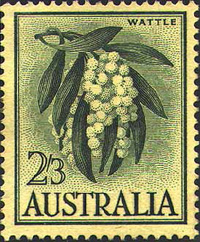 The 1959/60 stamp celebrating the Golden Wattle as, the then, unofficial national floral emblem Spring has at last sprung and the National Wattle Day is here (1st September). All around Sanctuary Lakes Resort, eye catching golden flowered Acacia trees/shrubs are waving large florets for the new spring season. Acacias, commonly called Wattles in Australia, are from the Mimosa family and one of the world’s oldest known tree/shrubs. Fossils have been found dating back millions of years. They grow in Europe, America, Africa and Asia; there are over 1,300 species in the world with about three quarters (900 plus) of them native to Australia.
The 1959/60 stamp celebrating the Golden Wattle as, the then, unofficial national floral emblem Spring has at last sprung and the National Wattle Day is here (1st September). All around Sanctuary Lakes Resort, eye catching golden flowered Acacia trees/shrubs are waving large florets for the new spring season. Acacias, commonly called Wattles in Australia, are from the Mimosa family and one of the world’s oldest known tree/shrubs. Fossils have been found dating back millions of years. They grow in Europe, America, Africa and Asia; there are over 1,300 species in the world with about three quarters (900 plus) of them native to Australia.
Acacias have been used in medicines, tannin, furniture and of course the strong fragrance of Acacia Farnesiana (the mimosa) has become an essential element to the world’s perfume industry.
The Acacia has always been part of our mythology. The Egyptians associated the acacia tree with characteristics of the tree of life, such as in the myth of Osiris and Isis. The “burning bush” which Moses encountered in the desert was believed to be an acacia tree. Also, when God gave Moses the instructions for building the Tabernacle, he said to make "a table of acacia wood". In the Christian tradition, Christ's crown of thorns is thought to have been woven from the African thorn acacia. And of course the Golden Wattle (Acacia pycnantha) is the floral emblem of Australia with September 1st as National Wattle Day.
The reason Acacias in Australia are named wattles comes from the fact that the Anglo-Saxon word 'Wattle' refers to flexible lengths of branches woven between stakes for the construction of fences. 'Wattle and daub' construction has the addition of a layer of mud, clay and hay to weatherproof into house walls. The huts of the early settlers were made using this 'wattle and daub' technique. The Acacia branches were found to be the most suitable and these trees soon became known as Wattles.
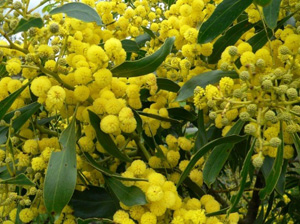 Golden Wattle (Acacia pycnantha) showing its distinctive flower bunches and leaf shapes Sanctuary Lakes has literally hundreds of Acacias/wattles thriving around the resort, so many in fact that it is difficult to know how many species are growing here. So I have selected four species that I know are easily observable in the boulevards, key streets and the golf course. I will try to give a location for all of them, but in some areas there are often three different species in the same place and to add to the complexity some Acacia species can interbreed, producing trees that have a little bit of each other’s recognisable differences.
Golden Wattle (Acacia pycnantha) showing its distinctive flower bunches and leaf shapes Sanctuary Lakes has literally hundreds of Acacias/wattles thriving around the resort, so many in fact that it is difficult to know how many species are growing here. So I have selected four species that I know are easily observable in the boulevards, key streets and the golf course. I will try to give a location for all of them, but in some areas there are often three different species in the same place and to add to the complexity some Acacia species can interbreed, producing trees that have a little bit of each other’s recognisable differences.
Acacia Pycnantha (Golden Wattle): The first of the “Fab Four” is the most well-known Acacia, our national floral emblem and prolific around the Resort. The Golden Wattle grows in profusion on the fringes of the boulevards and golf course, but the easy marker trees are in Sanctuary Lakes’ entrance. It is the first burst of Gold on the left hand side as you drive in from Point Cook Road and another Golden Wattle lies some 30 metres on.
The Golden Wattle tree is a shrub of about 4-8 metres. The flower head is a bunch of many tiny flowers each having five very small petals, almost hidden by the long stamens, and are arranged in dense rounded or elongated clusters.
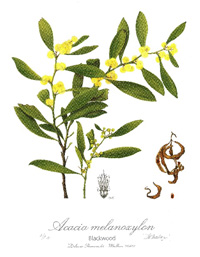 Dolores Sk-Malloni wonderful botanic painting of Acacia Melonoxylon clearly showing the distinctive whitey yellow flower’s position to the leaf and stem Plants are cross-pollinated by several species of honeyeater. In Sanctuary Lakes the New Holland and the White Plumed Honeyeaters are on the case, brushing against the flowers and transferring the pollen between them. After pollination it takes about 5-6 months for seed pods to mature, which is mainly towards January. The seeds are eagerly eaten by most birds ensuring a further wide distribution of the Golden Wattle.
Dolores Sk-Malloni wonderful botanic painting of Acacia Melonoxylon clearly showing the distinctive whitey yellow flower’s position to the leaf and stem Plants are cross-pollinated by several species of honeyeater. In Sanctuary Lakes the New Holland and the White Plumed Honeyeaters are on the case, brushing against the flowers and transferring the pollen between them. After pollination it takes about 5-6 months for seed pods to mature, which is mainly towards January. The seeds are eagerly eaten by most birds ensuring a further wide distribution of the Golden Wattle.
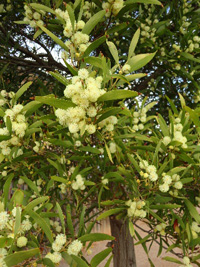 In full flower one of the Blackwood Wattle (Acacia Melanoxylon) trees on Celebration Drive Acacia Melanoxylon (Blackwood) is the tallest (16m to 20m) and longest living (up to 50 years) of the Acacia species. It is the only Acacia that has been planted in the Resort and are now strongly established in Celebration Drive.
In full flower one of the Blackwood Wattle (Acacia Melanoxylon) trees on Celebration Drive Acacia Melanoxylon (Blackwood) is the tallest (16m to 20m) and longest living (up to 50 years) of the Acacia species. It is the only Acacia that has been planted in the Resort and are now strongly established in Celebration Drive.
Like all acacias this is a fast growing perennial tree. A very tough tree and tolerates drought, poor drainage, any soil, salt air, gusty or cold winds and temperature extremes. It is an important host plant for a number of indigenous butterfly larvae, including the tailed emperor and the silky hairstreak. Hopefully Celebration Drive will become a home for these large bright butterflies.
Acacia Melanoxylon is also known for its Timber. Contrary to its common name Blackwood, the heartwood is golden to dark brown with chocolate growth rings. The wood is lustrous and possesses a fine to medium texture. The common name Blackwood may refer to dark stains on the hands of woodworkers, caused by the high levels of tannin in the timber. Besides being an excellent wood for furniture and decorative veneers, Blackwood is used in the crafting of top musical instruments, particularly guitars and violin bows.
Acacia Longifolia commonly called the Coastal Wattle: The most prodigious of the Wattles in Sanctuary Lakes. In fact according to some, it has become a weed. There is an excellent specimen at the Sanctuary Lakes Entrance way on the left hand side prior to the Boulevard roundabout.
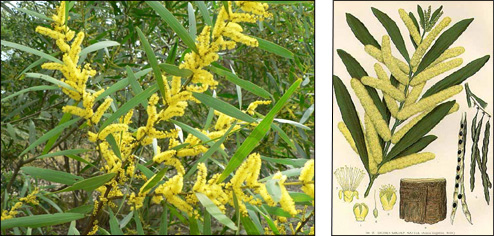
Although fast growing, up to 3-4 metres within two years, the Acacia Longifolia survives for only five to ten years. It is distinguished by its golden yellow flowers, densely arranged in elongated clusters (25-50 mm long), one or two of which are borne in each “leaf” fork. The “leaves” of this plant are not leaves in the true sense of the word - they are actually flattened and widened leaf stalks. It is called Coastal Wattle as it thrives in sandy soil and salty air. It is used for erosion control on sand dunes and through its root system is a great nitrogen distributor. Its flowers attracts bees and native birds that also feed on the long narrow seed pods, helping to propagate the seed for further growth.
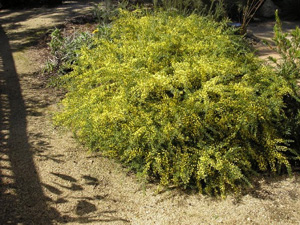 Gold Dust Wattle (Acacia Acinacea) scattered amongst the golf course and boulevard rough
Gold Dust Wattle (Acacia Acinacea) scattered amongst the golf course and boulevard rough
Acacia Acinacea - Gold Dust Wattle is the easiest to recognise of our Fab Four in that it is a bushy shrub, growing no more than 2 metres high. Branches may be arching, or occasionally stiff and upright; stems are somewhat angled at extremities.
The ‘Leaves’ like the Coastal Wattle are actually flattened leaf stalks, extremely variable shapes with some rounded and others elongated. The flower heads are profuse golden-yellow balls. Seed pods are rough, twisted and coiled many times 3-7cm long. Again the Lake’s bird population pollinate and propagate the Gold Dust to the many nooks and crannies of the Resort.
There are numerous other Acacias growing in and around Sanctuary Lakes including Acacia Baileyana (Cootamundra Wattle), Acacia Dealbata (Silver Wattle) and Acacia Floribunda (Gossamer Wattle). I am sure there are others to be discovered. Possibly, we can save these in the Rubik files for next year’s National Wattle Day, 1st September 2016.